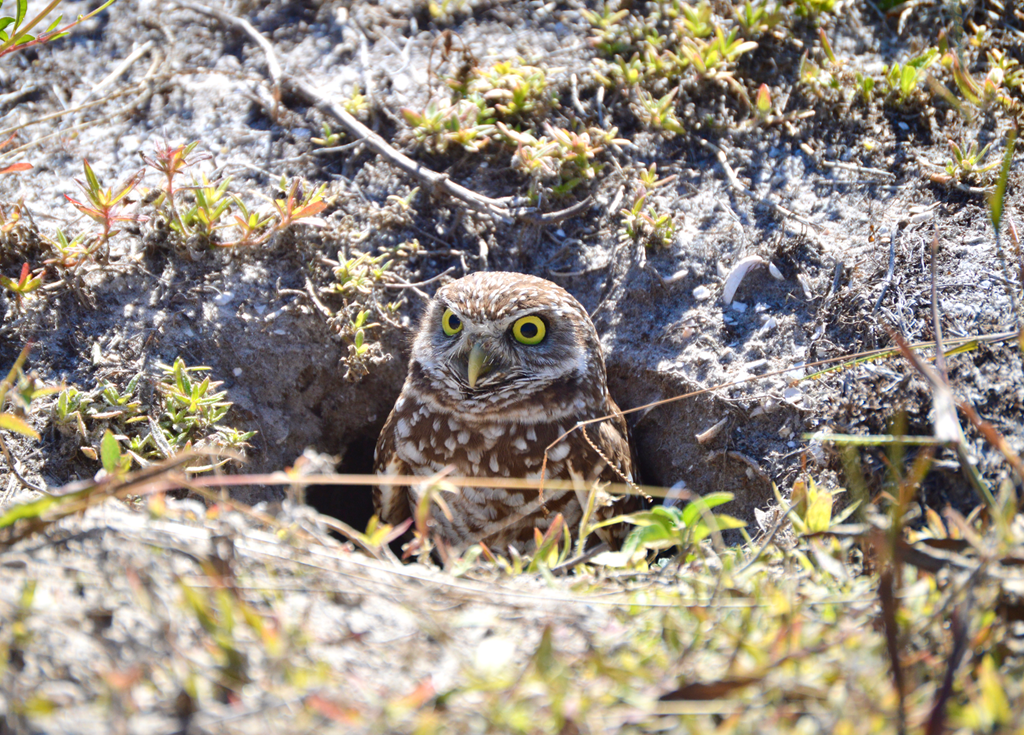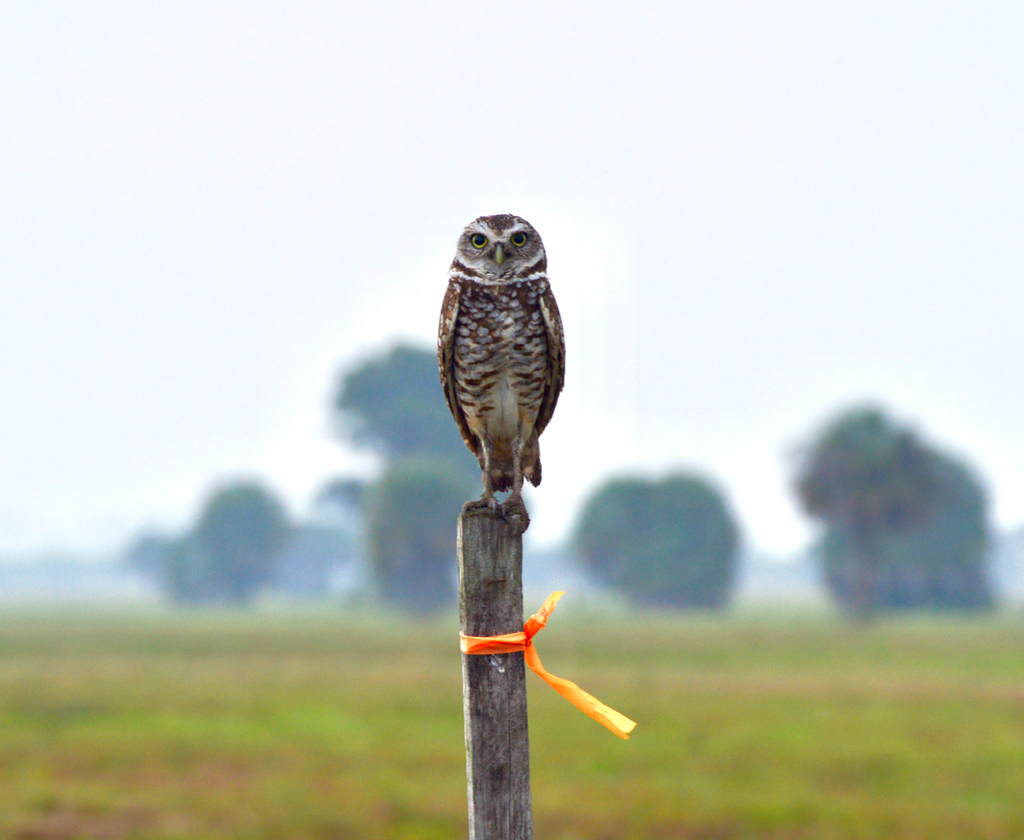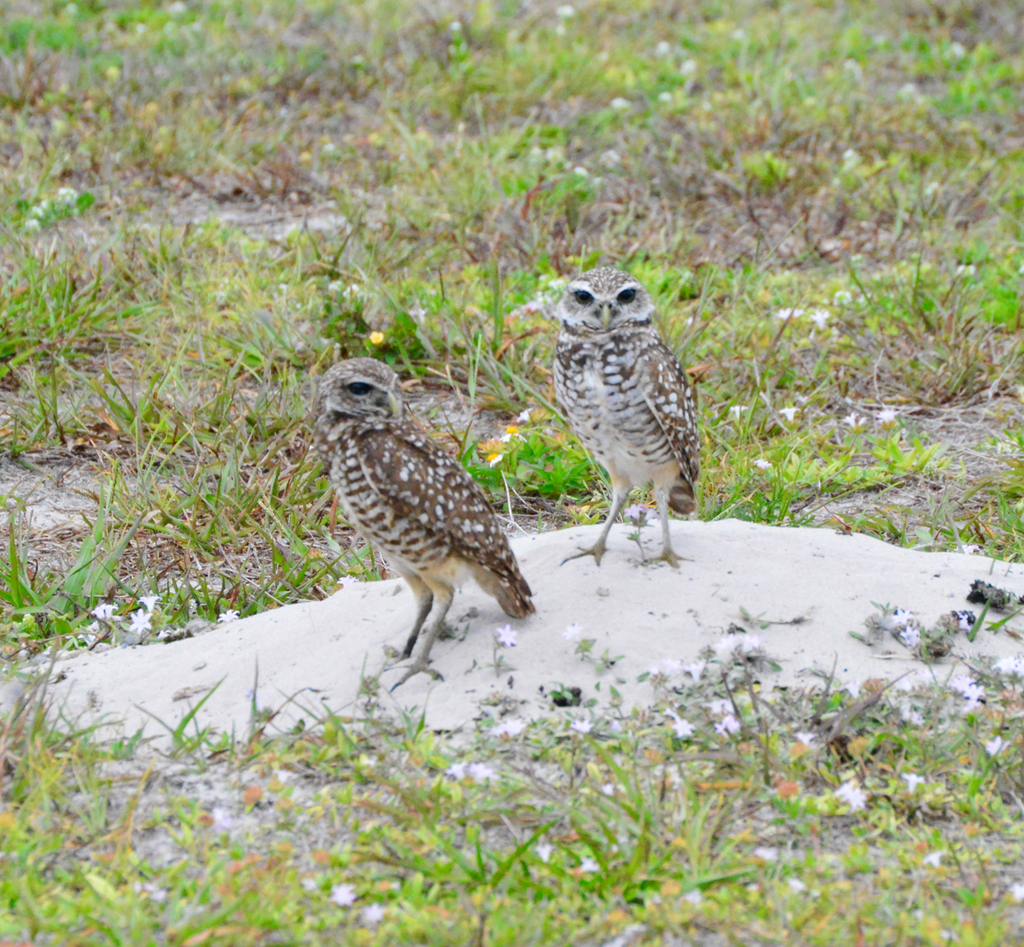When Raptors Roam Underground
Posted on in In the Field by Zoe Bonerbo, Former Conservation Education and Science Trainee

If you visit a hawk watch site during migration, you’ll see the counters training their binoculars at the sky. When at Hawk Mountain Sanctuary, we jokingly say we’re going to get "broad-wing neck” from craning upwards to look at high soaring raptors for long periods of time. However, when I went searching for burrowing owls (Athene cunicularia), I traded looking up to the sky for scanning holes on the ground.
Burrowing owls are the only raptor species to live underground. These little owls have a mottled brown and white pattern that often camouflages them with the sparsely vegetated terrain they burrow in. They are one of the few diurnal species of owls and nest in isolated pairs or colonies. Burrowing owls are found throughout the Americas, primarily on the west coast of the United States. However, there is a threatened subspecies that also resides in Florida (Athene cunicularia floridana). Native grassland habitat loss has been the primary driver of burrowing owl population decline in Florida. However, the sandy soils in Florida, unlike out west, are loose enough that the owls can dig their own burrows, meaning they don’t have to rely on abandoned burrows from other species such as gopher tortoises, badgers, and armadillos for shelter. This has allowed the owls to successfully colonize urban areas like vacant property lots, parks, airports, and sports fields. The urban population has more than doubled in the past five years to over 700 individuals due to heavy protection and research. However, up until this point there had been no recent assessment of the population status and habitat use of rural burrowing owls. This was the focus of my work with the Florida Fish and Wildlife Conservation Commission.

Our research aims were to assess and understand the population dynamics of rural burrowing owls. Can we estimate their rural population size, and what type of land are they commonly using for nesting? The study required conducting road side point counts during the breeding season from mid-March to mid-June. Days started at sunrise, driving out to pre-determined standard survey regions and using scopes and binoculars to scan as many designated points as we could until 11 a.m. We would then spend a few more hours conducting opportunistic point count surveys in areas we thought might be good habitat but had not been selected as a part of the standard survey model.
The start of the season was slow, as often is the case with field work, but it gave us time to adapt to the learning curve. We learned to tackle problems like the mid-day Florida heat haze that obscures your vision. We refined our ability to identify confusing grassland birds that occasionally looked like burrowing owls. Every few days we would have a stroke of luck and find an individual owl perched on a fence line or standing watch outside its burrow. As the season progressed, we started noticing changes in behavior. Foraging behavior was more frequent. Pairs (an adult male and female) began appearing more commonly together outside the nest indicating their eggs had hatched and no longer needed incubation. About 2 weeks later in late April, the average time it takes chicks to emerge from the burrow, we started seeing puff balls appear from the ground for the first time.
Around this time, we also had some big breakthroughs. We found three “hotspots” with colonies of 20+ rural burrowing owls. Our highest density cluster before had only been 8. These hotspots all occurred on private cattle grazing land, and interestingly, the presence of several dozen cows seemed to have little effect on the success or behavior of the nesting owls. Why there are hotspots in these areas is still a mystery, but it is exciting how much potential research could be done. I hypothesize there is more to habitat selection than the seeing eye can detect through a scope, such as soil composition and foraging ability.

There were also noticeable physiological and behavioral differences between rural and urban burrowing owls. Urban owls displayed smaller home ranges, as small as a person’s front yard, and a greater tolerance for human disturbance. Whereas rural owls were found primarily on open land several acres or larger, away from highly trafficked areas like highways. Urban owls also displayed unique dark brown and green eye colorations in addition to the classic golden eye color the species is known for.
Over the course of three months we found several hundred previously unknown individuals and colonies across Florida, primarily on open short-grass farmland. Going forward, the data collected will be used to produce a rural burrowing owl population estimate and refine the model of suitable habitat sectors in Florida. Ultimately the goal is to make sure burrowing owl populations are stable or growing over the next ten years. Although Florida burrowing owls are not as common as their historical numbers, I am confident that future research and conservation efforts can encourage growth in the species population.
I would like to thank the Florida Fish and Wildlife Conservation Commission for the opportunity to work on this project as well as my supervisor Juan Oteyza and coworker Eden Ravecca. For more information please visit Burrowing Owls of Marco Island on Facebook and MyFWC.com.